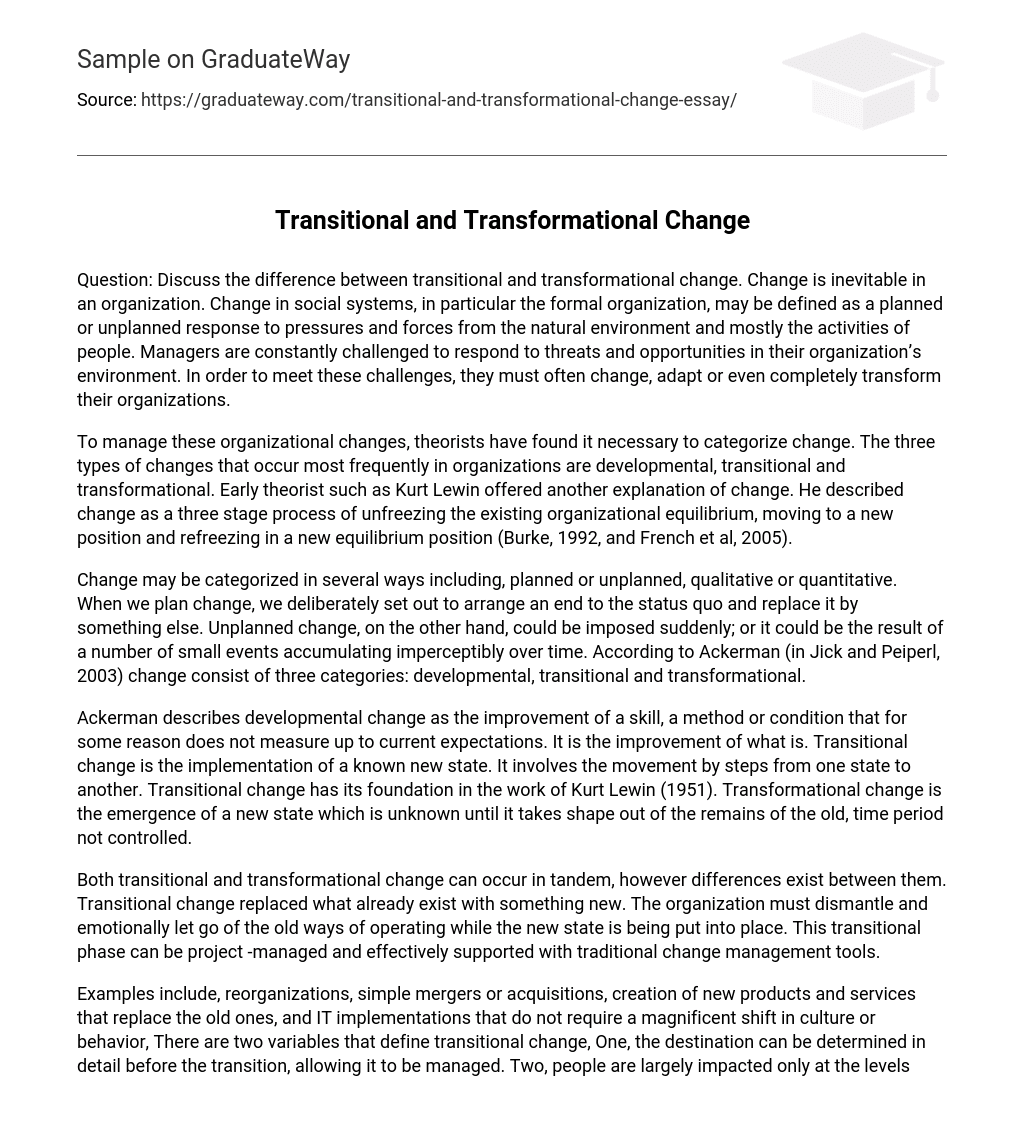Question: Discuss the difference between transitional and transformational change. Change is inevitable in an organization. Change in social systems, in particular the formal organization, may be defined as a planned or unplanned response to pressures and forces from the natural environment and mostly the activities of people. Managers are constantly challenged to respond to threats and opportunities in their organization’s environment. In order to meet these challenges, they must often change, adapt or even completely transform their organizations.
To manage these organizational changes, theorists have found it necessary to categorize change. The three types of changes that occur most frequently in organizations are developmental, transitional and transformational. Early theorist such as Kurt Lewin offered another explanation of change. He described change as a three stage process of unfreezing the existing organizational equilibrium, moving to a new position and refreezing in a new equilibrium position (Burke, 1992, and French et al, 2005).
Change may be categorized in several ways including, planned or unplanned, qualitative or quantitative. When we plan change, we deliberately set out to arrange an end to the status quo and replace it by something else. Unplanned change, on the other hand, could be imposed suddenly; or it could be the result of a number of small events accumulating imperceptibly over time. According to Ackerman (in Jick and Peiperl, 2003) change consist of three categories: developmental, transitional and transformational.
Ackerman describes developmental change as the improvement of a skill, a method or condition that for some reason does not measure up to current expectations. It is the improvement of what is. Transitional change is the implementation of a known new state. It involves the movement by steps from one state to another. Transitional change has its foundation in the work of Kurt Lewin (1951). Transformational change is the emergence of a new state which is unknown until it takes shape out of the remains of the old, time period not controlled.
Both transitional and transformational change can occur in tandem, however differences exist between them. Transitional change replaced what already exist with something new. The organization must dismantle and emotionally let go of the old ways of operating while the new state is being put into place. This transitional phase can be project -managed and effectively supported with traditional change management tools.
Examples include, reorganizations, simple mergers or acquisitions, creation of new products and services that replace the old ones, and IT implementations that do not require a magnificent shift in culture or behavior, There are two variables that define transitional change, One, the destination can be determined in detail before the transition, allowing it to be managed. Two, people are largely impacted only at the levels of skills and actions, not the more personal levels of mindset, behavior and culture.
Transformational change differs from transitional change for two distinct reasons. First, the future state is unknown when the transformation begins and is determined through visioning and trial- and –error as new information is gathered. This makes it impossible to manage transformation with predetermined, time bound and linear project plans. An overarching change strategy can be created but the actual change process must emerge as you go. This means that executives, managers and front-line workers alike must operate in the unknown.
Second, the future state is so radically different from the current state that people and culture must change to successfully implement it. New mindsets and behaviors are required. In fact market requirements force fundamental change in strategy, operations, and world views. Transitional change is evolutionary, providing gradual improvements while transformational change is revolutionary, affecting the whole organization at once. Transitional changes are essential for short term success; however it cannot sustain an organization’s long term survival in the face of pressure.
Several factors in the contemporary business environment impacts on the way organizations conduct business. Such factors include the growth in information technology, globalization, improvements in communication and transportation, more educated and technically inclined employees and rising customer expectations. These factors are causing many organizations to recognize the changes that are occurring within the organization and to manage them effectively and efficiently for the growth and sustainability of he organization. Changes take place in organizations. Several types of changes can occur in an organization, including planned and unplanned changes, developmental, transitional and transformational changes. Transformational change differs from other change related concepts in terms of the philosophical nature of the new vision for the organization, the required level of involvement (commitment) from the internal stakeholders and the prominence of transformation in the business environment.
However, almost all successful organizations evolve through relatively long periods of transitional change combined with bursts of transformational change. By categorizing change managers can implement strategies to manage these changes. Reference: Ackerman, L (1997) Development, transition or transformation: the question of change in organizations. In: Van Eynde, D. , Hoy, J and Van Eynde, D (eds), Organization Development Classics. San Francisco, Jossey Bass. Lewin, K (1951) Field Theory in Social Science New York, Harper Row.





